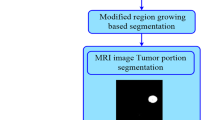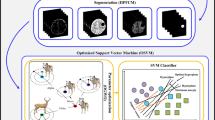Abstract
Multiclass brain tumor classification is performed by using a diversified dataset of 428 post-contrast T1-weighted MR images from 55 patients. These images are of primary brain tumors namely astrocytoma (AS), glioblastoma multiforme (GBM), childhood tumor-medulloblastoma (MED), meningioma (MEN), secondary tumor-metastatic (MET), and normal regions (NR). Eight hundred fifty-six regions of interest (SROIs) are extracted by a content-based active contour model. Two hundred eighteen intensity and texture features are extracted from these SROIs. In this study, principal component analysis (PCA) is used for reduction of dimensionality of the feature space. These six classes are then classified by artificial neural network (ANN). Hence, this approach is named as PCA-ANN approach. Three sets of experiments have been performed. In the first experiment, classification accuracy by ANN approach is performed. In the second experiment, PCA-ANN approach with random sub-sampling has been used in which the SROIs from the same patient may get repeated during testing. It is observed that the classification accuracy has increased from 77 to 91 %. PCA-ANN has delivered high accuracy for each class: AS—90.74 %, GBM—88.46 %, MED—85 %, MEN—90.70 %, MET—96.67 %, and NR—93.78 %. In the third experiment, to remove bias and to test the robustness of the proposed system, data is partitioned in a manner such that the SROIs from the same patient are not common for training and testing sets. In this case also, the proposed system has performed well by delivering an overall accuracy of 85.23 %. The individual class accuracy for each class is: AS—86.15 %, GBM—65.1 %, MED—63.36 %, MEN—91.5 %, MET—65.21 %, and NR—93.3 %. A computer-aided diagnostic system comprising of developed methods for segmentation, feature extraction, and classification of brain tumors can be beneficial to radiologists for precise localization, diagnosis, and interpretation of brain tumors on MR images.


Similar content being viewed by others
References
Caselles V: Geodesic active contours. Int J Comput Vision 22(3):61–79, 1997
Clark MC, Hall LO, Goldgof DB, Velthuizen R, Murtagh FR, Silbiger MS: Automatic tumor segmentation using knowledge-based techniques. IEEE Trans Med Imaging 17(2):187–2011, 1998
Xu C, Prince JL: Snakes, shapes, and gradient vector flow. IEEE Trans Image Process 7(3):359–369, 1998
Lynn M, Lawerence OH, Demitry B, Goldgof RMF: Automatic segmentation of non-enhancing brain tumors. Artif Intell Med 21:43–63, 2001
Dou W, Ruan S, Chen Y, Bloyet D, Constans J: A framework of fuzzy information fusion for the segmentation of brain tumor tissues on MR images. Image Vis Comput 25:164–171, 2007
Wang T, Cheng I, Basu A: Fluid vector flow and applications in brain tumor segmentation. IEEE Trans Biomed Eng 56(3):781–789, 2009
Haralick RM, Shanmugam K, Dinstein I: Textural features for image classification. IEEE Trans Systems Man Cybernet 3:610–621, 1973
Selvaraj H, Thamarai Selvi S, Selvathi D, Gewali LB: Brain MRI slices classification using least squares support vector machine. J Intell Comput Med Sci 1:21–33, 2009
Kharrat A, Gasm K: Hybrid approach for automatic classification of brain MRI using genetic algorithm and support vector machine. Leonardo Journal of Sciences 17:71–82, 2010
Zacharaki EI, Wang S, Chawla S, Yoo DS, Wolf R, Melhem ER, Davatzikos C: Classification of brain tumor type and grade using MRI texture in a machine learning technique. Magn Reson Med 62:1609–1618, 2009
Georgiardis P, Cavouras D, Kalatzis I, Daskalakis A, Kagadis GC, Malamas M, Nikifordis G, Solomou E: Improving brain tumor characterization on MRI by probabilistic neural networks on non-linear transformation of textural features. Comput Meth Prog Bio 89:24–32, 2008
Georgiardis P, Cavouras D, Kalatzis I, Daskalakis A, Kagadis GC, Malamas M, Nikifordis G, Solomou E: Non-linear least square feature transformations for improving the performance of probabilistic neural networks in classifying human brain tumors on MRI. Lecture Notes on Computer Science 4707:239–247, 2007
El-Dahshan EA, Hosny T, Badeeh A, Salem M: Hybrid MRI techniques for brain image classification. Digital Signal Process 20:433–44, 2009
Specht DF: Probabilistic Neural Networks 3:109–118, 1990
Ahmed NU, Rao R: Orthogonal transforms for digital signal processing. Springer, Heidelberg, 1975
Sachdeva J, Kumar V, Gupta I, Khandelwal N, Ahuja CK: A novel content based brain tumor segmentation. Mag Reson Imaging 30(5):694–715, 2012
Ojala T, Pietikäinen M, Mäenpää T: Multi resolution gray-scale and rotation invariant texture classification with local binary pattern. IEEE Trans Pattern Anal Machine Intell 24:971–998, 2002
Idrissa M, Acheroy M: Texture classification using Gabor filters. Pattern Recognition Lett 23:1095–1102, 2002
Zhang J, Tan T, Ma L: Invariant texture segmentation via circular Gabor filters. In. Proc: Sixteenth International Conference on Pattern Recognition, Quebec City, Canada, 2: 901–904, 2002
Jain AK, Duin RPW, Jianchang M: Statistical pattern recognition. A review. IEEE Trans Pattern Anal Mach Intell 22:4–37, 2000
Duda RO, Hart PE, Stork DG: Pattern classification. Wiley, New York, 2001
Kumar V, Sachdeva J, Gupta I, Khandelwal N, Ahuja C K: Classification of brain tumors using PCA-ANN. In Proceedings WICT, Mumbai, India, 1079–1083, 2011. doi:10.1109/WICT.2011.6141398
Author information
Authors and Affiliations
Corresponding author
Additional information
The work has been done as a collaborative project to develop an interactive CAD system to assist radiologists under MOU between IIT Roorkee and PGIMER, Chandigarh, India.
Rights and permissions
About this article
Cite this article
Sachdeva, J., Kumar, V., Gupta, I. et al. Segmentation, Feature Extraction, and Multiclass Brain Tumor Classification. J Digit Imaging 26, 1141–1150 (2013). https://doi.org/10.1007/s10278-013-9600-0
Published:
Issue Date:
DOI: https://doi.org/10.1007/s10278-013-9600-0




